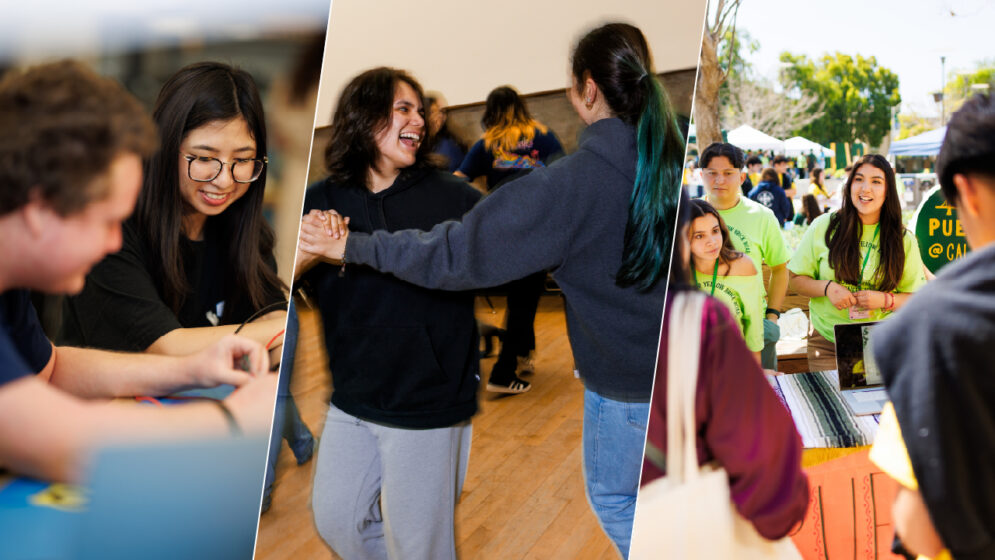Featured
Behind the Scenes
Follow the student cast and crew of Cal Poly’s production of “Clue: The Musical” as they put Learn by Doing on center stage.
Share this article:
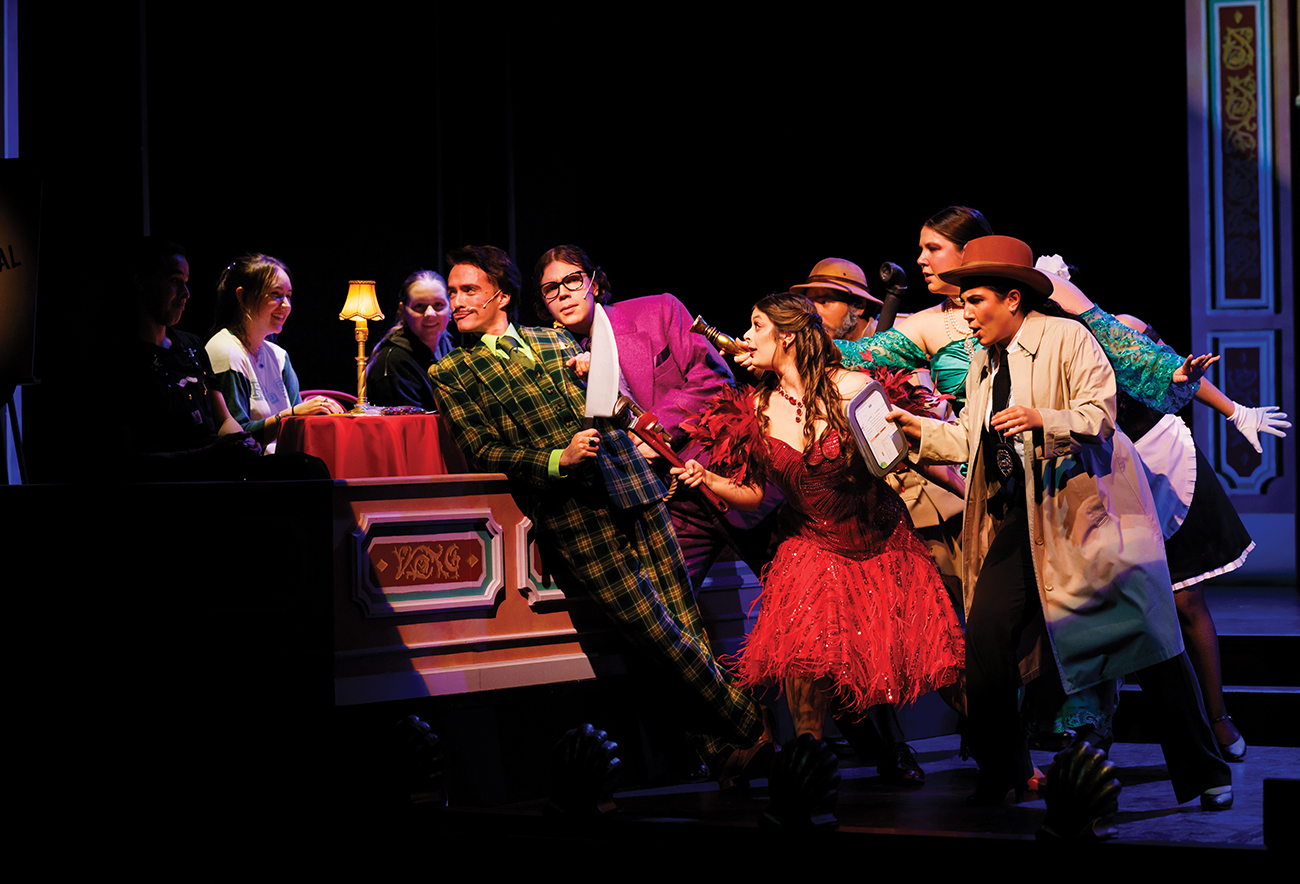
The cast interacts with audience members seated on stage at the preview performance.
Thunder crashes. Six sinister figures advance through flickers of lightning. Weapons flash in the darkness — a knife, a rope, a candlestick — and a body slumps to the floor, sprawled across a set of steps.
There’s been a murder. And it’s your job to help solve it.
No, a brutal crime has not actually been committed. It’s the Theatre and Dance Department’s spring production of “Clue: The Musical,” a musical comedy based on the classic mystery board game. And this moment, the climax of act one on the opening night of a two-week run, is the culmination of months of planning, hard work, long rehearsals and a lot of Learn by Doing.
“Right now, my life is: I wake up, I go to school, I go to rehearsal, and then I fall asleep. There’s not much else happening in between,” says Isaac Lewis, a fourth-year theater major and music minor who plays Mr. Boddy, the story’s victim and the show’s emcee. “It’s pretty much all I can think about — and I love it.”
Over winter quarter, Cal Poly Magazine went behind the scenes with the student cast and crew to find out what it takes to put a production together.
A Comprehensive Theatrical Education
Each year, the department presents three main stage productions, including at least one straight drama and one musical. While faculty members direct each show and teach classes that develop elements like sound, lighting, sets and costumes, the bulk of the work is done by students.
Cal Poly’s theater major is a bachelor of arts program, structured on the concept of students learning a little bit of everything within the discipline. While some students might naturally gravitate toward certain elements of production, every student is required to try everything in order to graduate.
“You could be a master actor, sure. But you’re also going to learn how to guide a production from soup to nuts — to be able to create the set and the scenic design, focus the lights, figure out a soundscape and program it with digital tools,” says associate professor and “Clue” director Karin Hendricks. “Our students graduate knowing how to do all of those things, and then they will leave Cal Poly with the skill set to book jobs immediately.”

The murder suspects surround “Mr. Boddy” actor Isaac Lewis in a pivotal scene.
Much of the program’s course work directly supports each quarter’s mainstage production. In classes like Stagecraft and Advanced Costume Construction, students earn credits by building and creating the elements that will appear in the play.
“Our labs and activity classes exemplify the Learn by Doing model,” says Brian Healy, Theatre and Dance Department faculty chair and the production’s lighting designer. “Students are engaged in practice, in building, in painting, in both traditional theatrical techniques and in utilizing state-of-the art technology. Students are given the opportunity to create, implement and solve problems.”
On a show like this, the challenges are as big as the ambitions. This production requires elaborate, interactive set pieces inspired by the board game, live music being played on stage as part of the story, and even subtle sleight-of-hand magic.
As if that all wasn’t enough, this show has one additional twist: Just like in the game the musical is based on, the “players” in the audience are trying to solve the murder mystery by guessing who did it, in what room, and with which weapon based on a series of clues uncovered throughout the play.
Each performance is different — at the beginning of the show, Lewis, in character as Mr. Boddy, invites audience members to the stage to randomly draw cards that will select the secret conclusion of the mystery in advance: the suspect, the murder weapon and the location. That means that on any given night, the cast and crew will have to think on their toes because any one of 216 endings is possible.
The cast runs through the full show at the final dress rehearsal before opening night.
Choreographing the Play
In a practice room in Davidson Hall, the cast is working through the choreography of the play’s climactic scene, the big dance number leading up to the final reveal. The suspects come together, split apart, and regroup in a line as a suspicious detective inspects them each in turn.
Marya Wanous, a first-year communication major, is at the center of the action in this scene. An experienced actress from elementary through high school, she’s playing the detective in her first role at Cal Poly. “This is a way more intense experience than I ever had in high school,” says Wanous. “It’s not just like, ‘Stand here, say your line.’ Every detail matters, and Karin has such unique, creative ideas for helping me develop my character. I’ve never experienced anything like that before.”
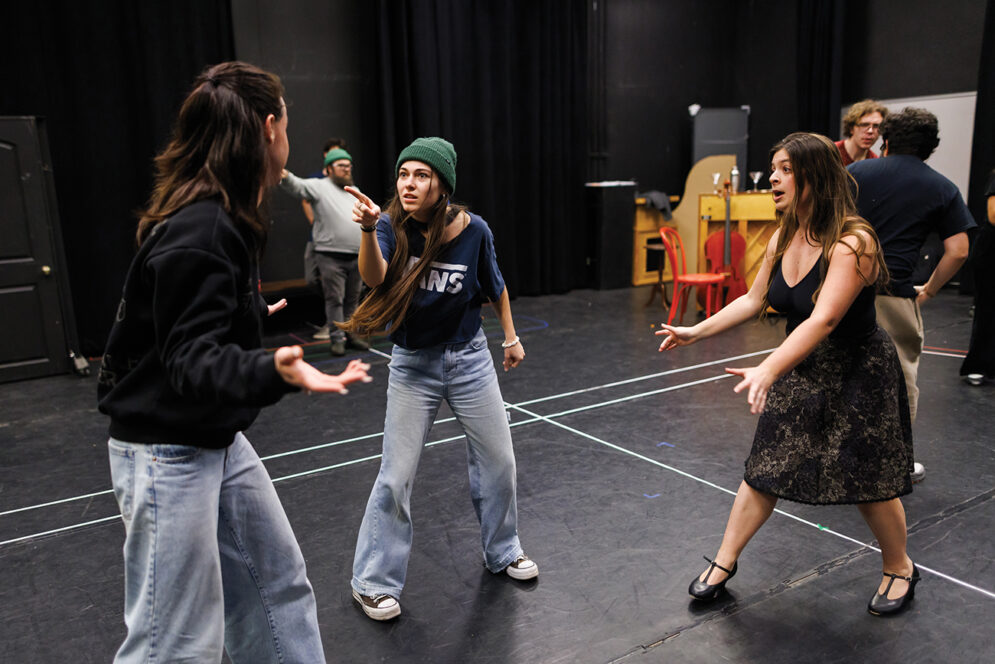
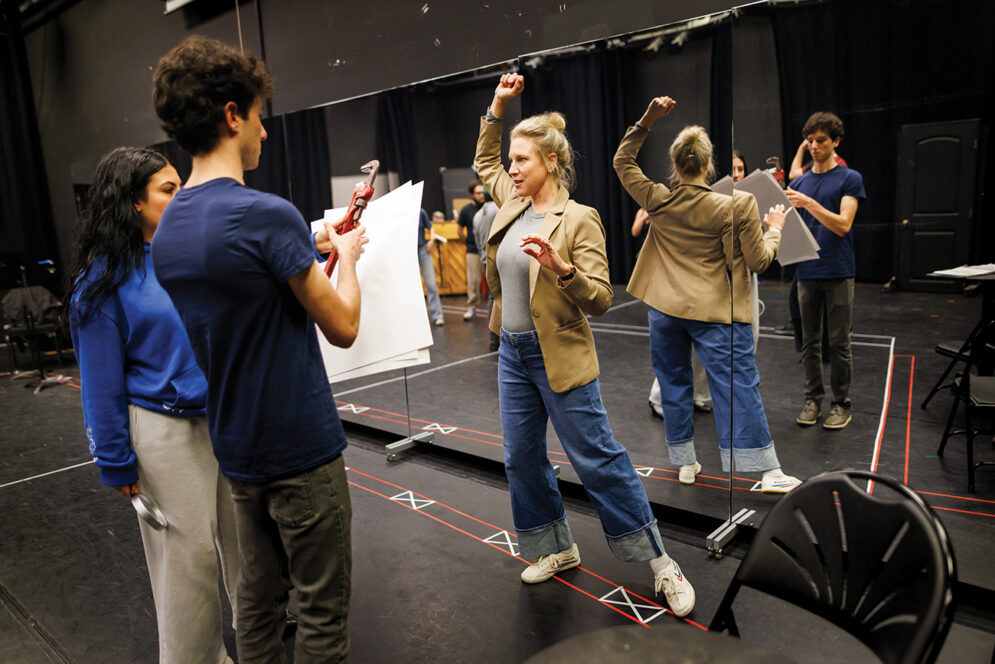
First photo: Assistant director Ella Marchal (center) and “Miss Scarlett” actress Joelle Andrews (right) work on choreography. Second photo: Director Karin Hendricks (right) works with actors Marya Wanous and Isaac Lewis on staging the big reveal at the show’s climax.
Ella Marchal is helping Hendricks oversee it all. The fourth-year theater major, who frequently appears in the department’s productions as an actor, is trying a new role this time: assistant director. The job involves taking copious notes, commitment to and familiarity with the creative vision, and an ability to cover any role needed at a moment’s notice.
“I’ve been in theater for years, but I didn’t realize exactly how much it took to put on a play,” she says. “You come and see a play, you see the set, you see the costumes and you see the actors perform. But you don’t really take into account every single thing that had to fall into place to make that all work together. Even as an actor, I was never fully aware of all it takes.”
Sets and Scenes
A massive, warehouse-like workshop bubbles with sound and activity as dozens of students assemble the set pieces for the production.
In one corner, two students are using a band saw to trim long boards down to size. Along another wall, a 3D printer is giving form to a semi-transparent cone reminiscent of the top of an oversized Clue game piece. And throughout the shop, students are huddled in groups of two or three, often singing along with a speaker playing pop music as they sand and paint the portable walls and columns that will give shape to the story on stage.
“It’s really satisfying to work with your hands and see all this come together,” says Cosmo White, a fourth-year theater arts major who has done carpentry and lighting design on several Cal Poly productions. “You’ve got all these people coming together to make a big piece of art.”
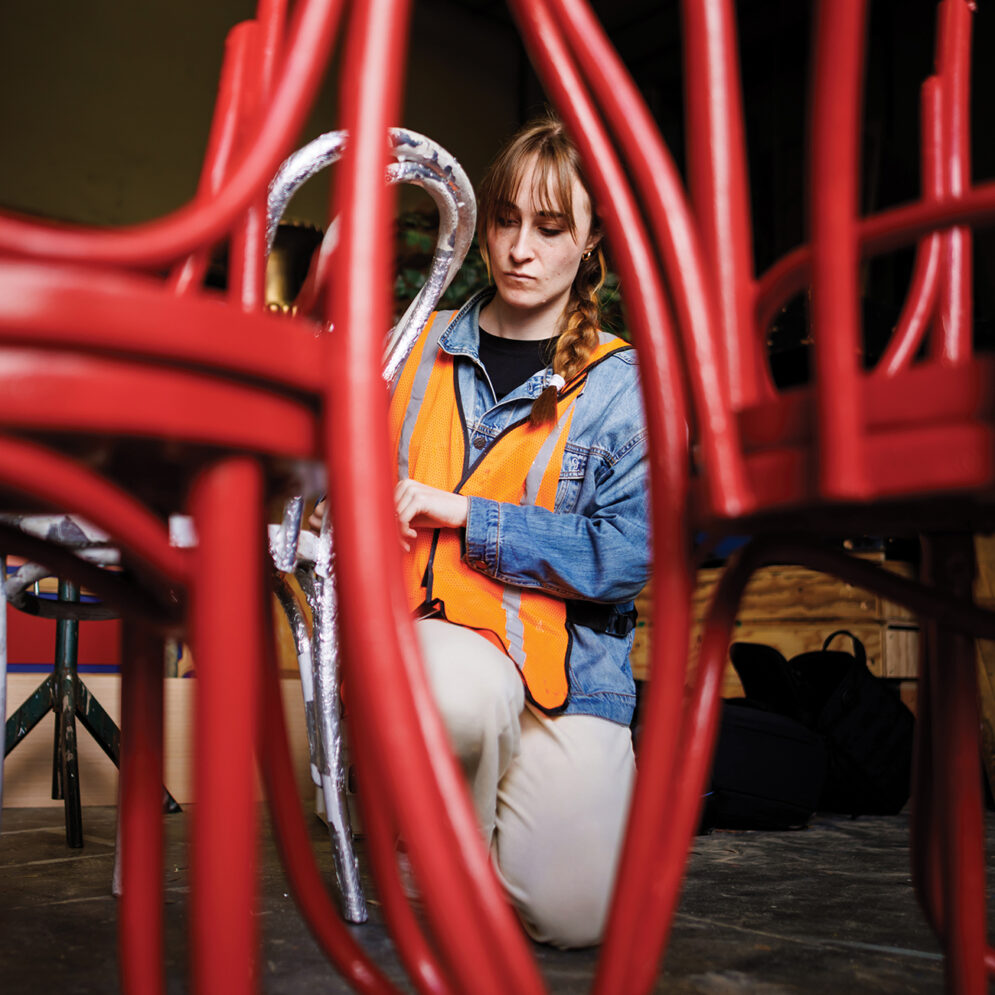
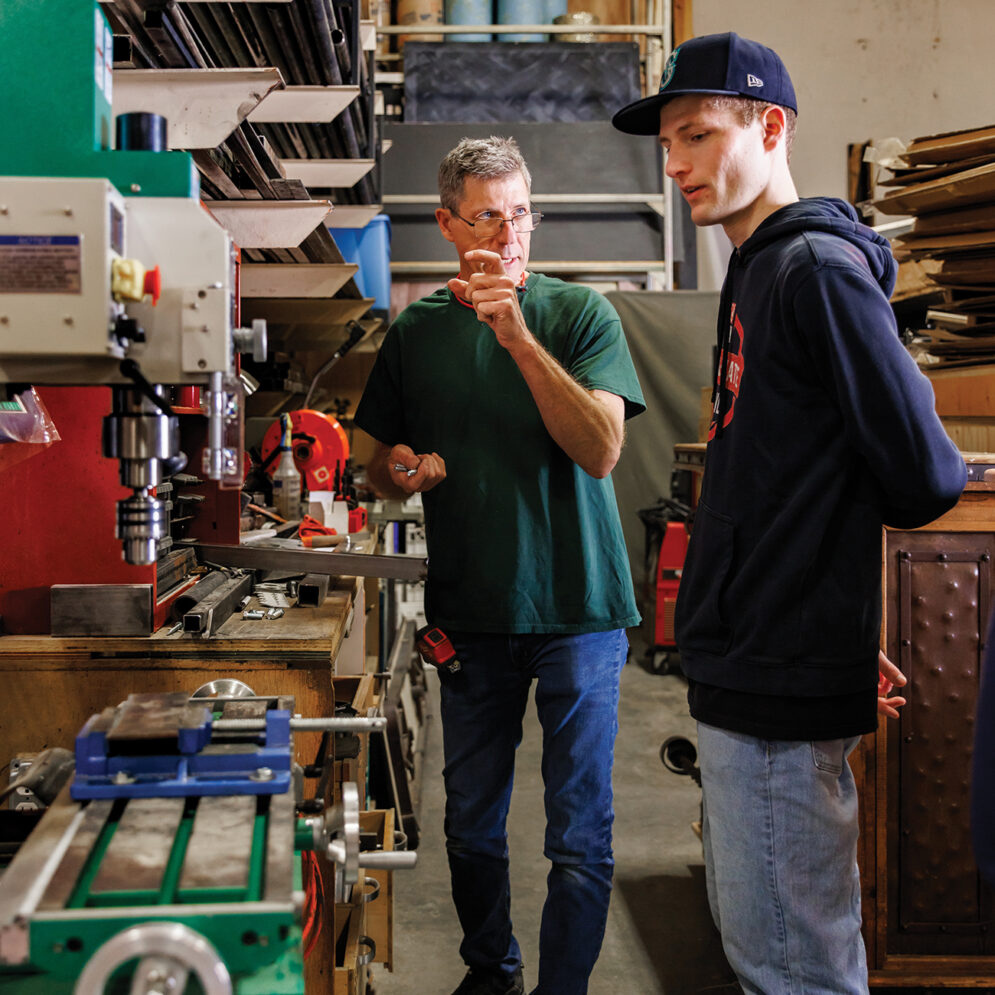
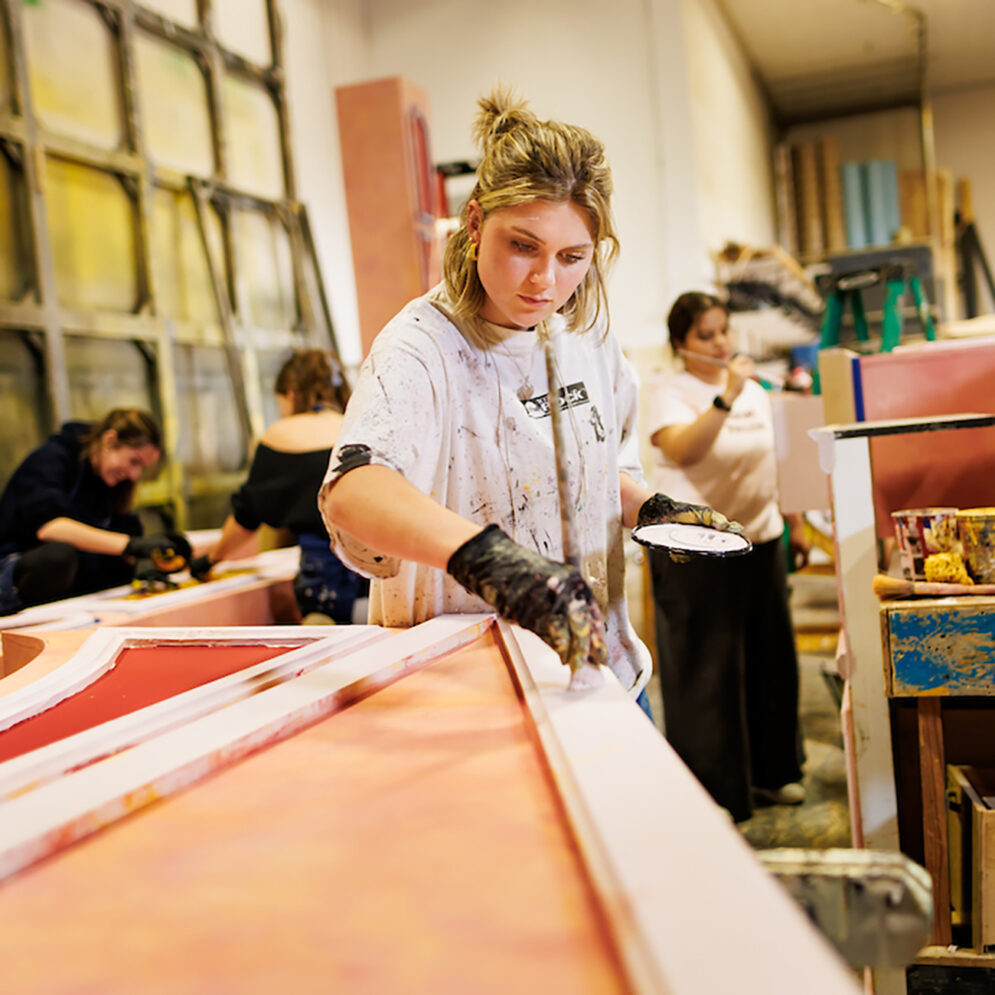
First photo: A student paints furniture for the interactive set. Middle: Richard Jackson walks a student through tool safety in the scene shop. Third photo: A student paints a section of the main set during a set design lab.
The centerpiece of the Victorian-inspired set is modeled on 19th-century toy theaters, and when placed on stage will give the play a theater-within-a-theater effect. That smaller set on stage houses an automatic backdrop that changes to instantly shift the scene among the six famous rooms in Boddy Manor. The device was a custom innovation designed and built by the tech crew, because similar products aren’t available at the size needed.
“A lot of times in theater, we’ll take a material or a process and we’ll use it in a completely unexpected way to achieve our goal,” says Jason Bolen, a Theatre and Dance Department lecturer who led the set design team and co-teaches the stagecraft class. “Stagecraft is all about thinking about things in different ways and creative problem solving.”
Students in the stagecraft class assemble and paint the show’s set pieces in a workshop connected to the main stage.
Stitching the Show Together
In a large room that takes up most of a small modular building behind Davidson Hall, faculty member and costume designer Thomas Bernard is running a joint session of the department’s beginner and advanced costume construction courses.
Ten students are sewing a kaleidoscope of costume pieces: An emerald and sage plaid suit for Mr. Green, billowing khaki jodhpurs for Col. Mustard, a frilly apron for Mrs. White. Bernard himself is working with hundreds of ruby sequins on Miss Scarlett’s bodice.
“These students all started on different levels,” he says. “Some students here had never picked up a needle until coming into class, and now they all can hand sew and machine sew.”
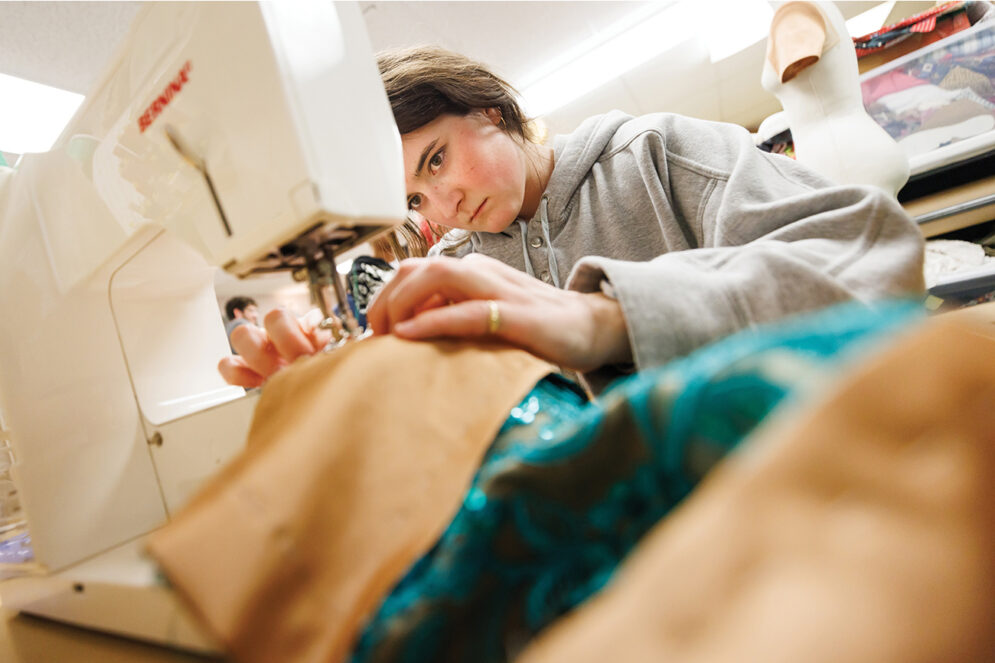
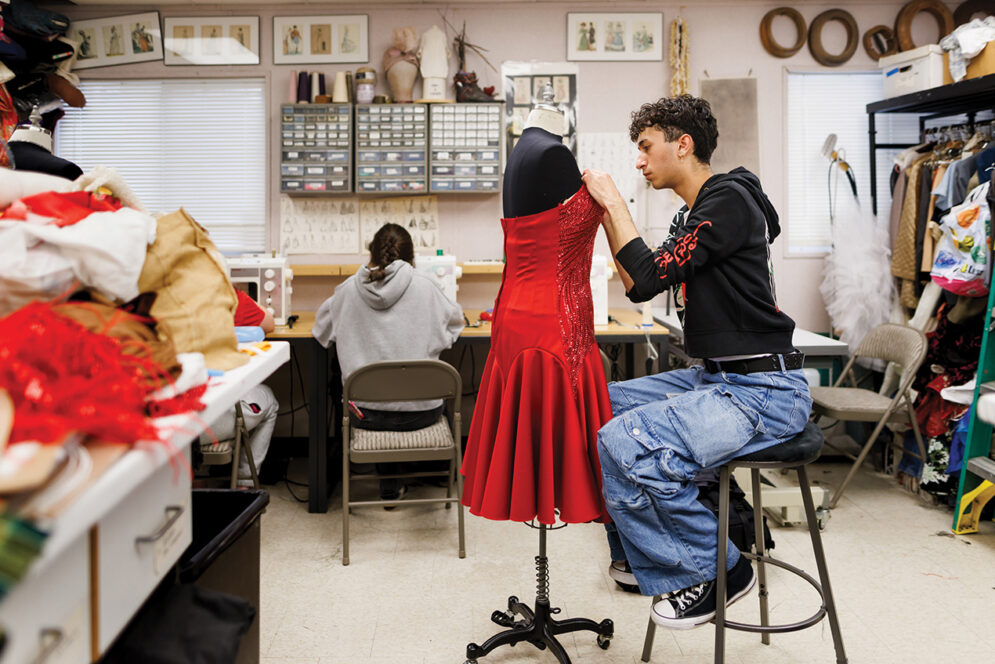
Student costumers Vivian Morse (first photo) and Isaiah Covarrubias (second photo) work on two of the show’s elaborate gowns.
But besides the technical skills, the students are learning a more universal lesson as they assemble the play’s costumes: collaboration.
“It can feel kind of individual when you’re just focused on the piece you’re working on,” says Sof Rakowski, a second-year theater arts major who also works as a student assistant in the department. “Then you see what everyone else is working on at the same time. And you come back the day after and someone else has helped you get further along on what you were working on before. It’s all coming together in service of the larger vision.”
That sense of teamwork is especially important for Vivian Morse, an interdisciplinary studies major pursuing a career in fashion marketing. Because she’s in a custom-designed program, she doesn’t have a home cohort of people sharing her major, so she’s taken this class twice now — both to level up her hands-on fashion experience, and to share the intense camaraderie found among the theater crowd.
“It’s really fun to be able to feel more part of a team and become close with people in my classes,” she says. “I like seeing how this department functions, especially because it’s so small and everyone’s so close. It’s such a welcoming community on campus.”
Students in the costume construction course design and assemble the show’s elaborate costumes.
On the Stage
One week before opening night, the cast and crew are bringing all the disparate elements of the production together in Spanos Theatre, the department’s main performance venue.
It’s tech week, and it’s the first time that all the different teams are together: Actors are on the stage, the set pieces have been rolled into the theater from the adjacent workshop, costumes are getting their final fittings, and sound and lighting students are in their booths cueing up the visual and audio effects that will shape the performance.
One by one, the actors come out onto the stage to perform a bit of dialogue and a few bars of song while the sound crew sets levels on their microphones.
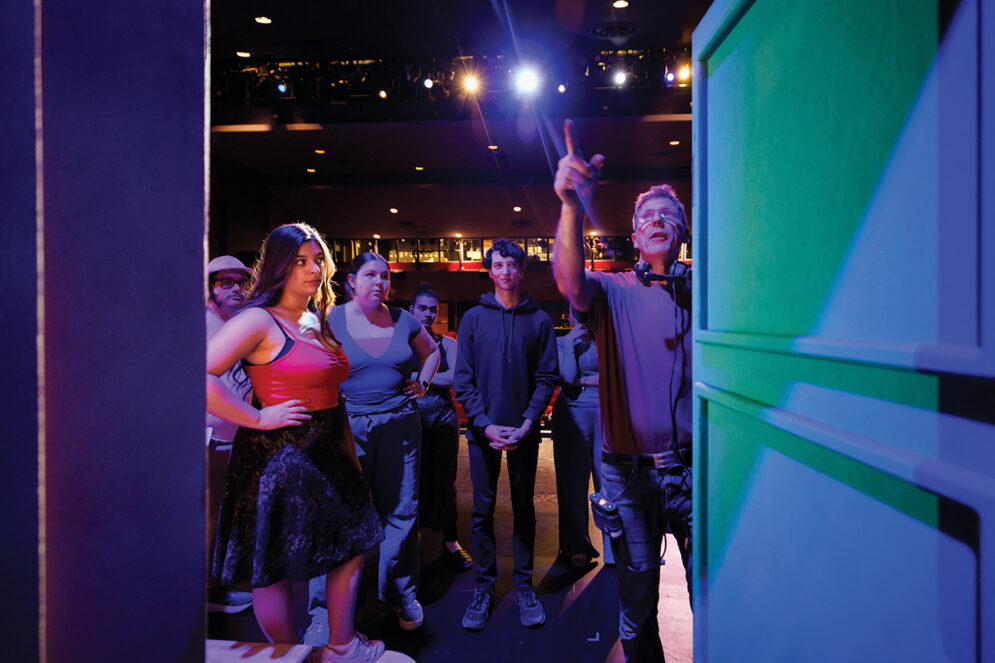
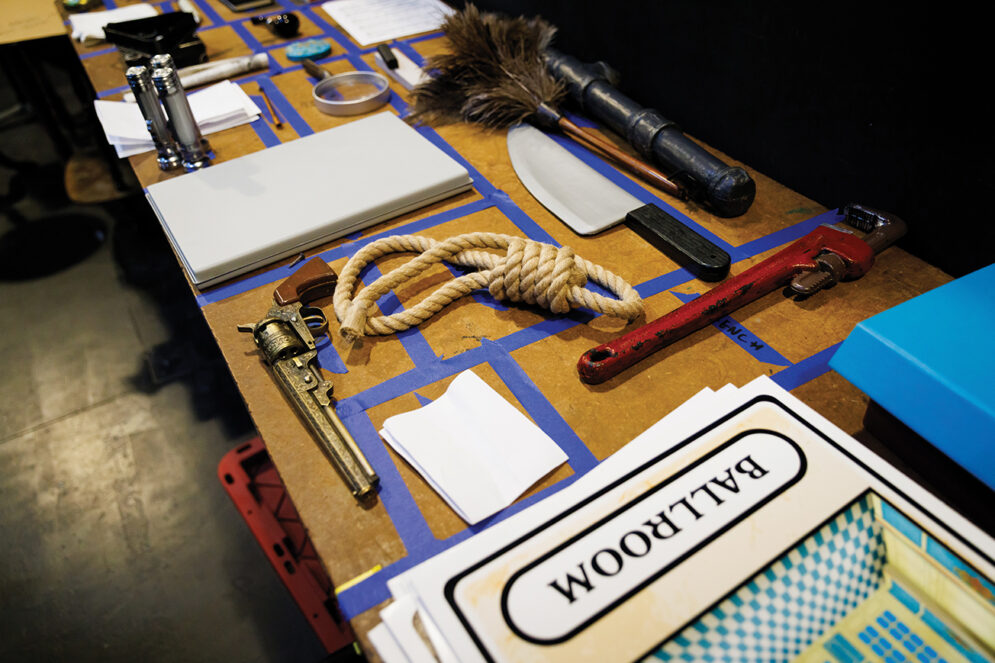
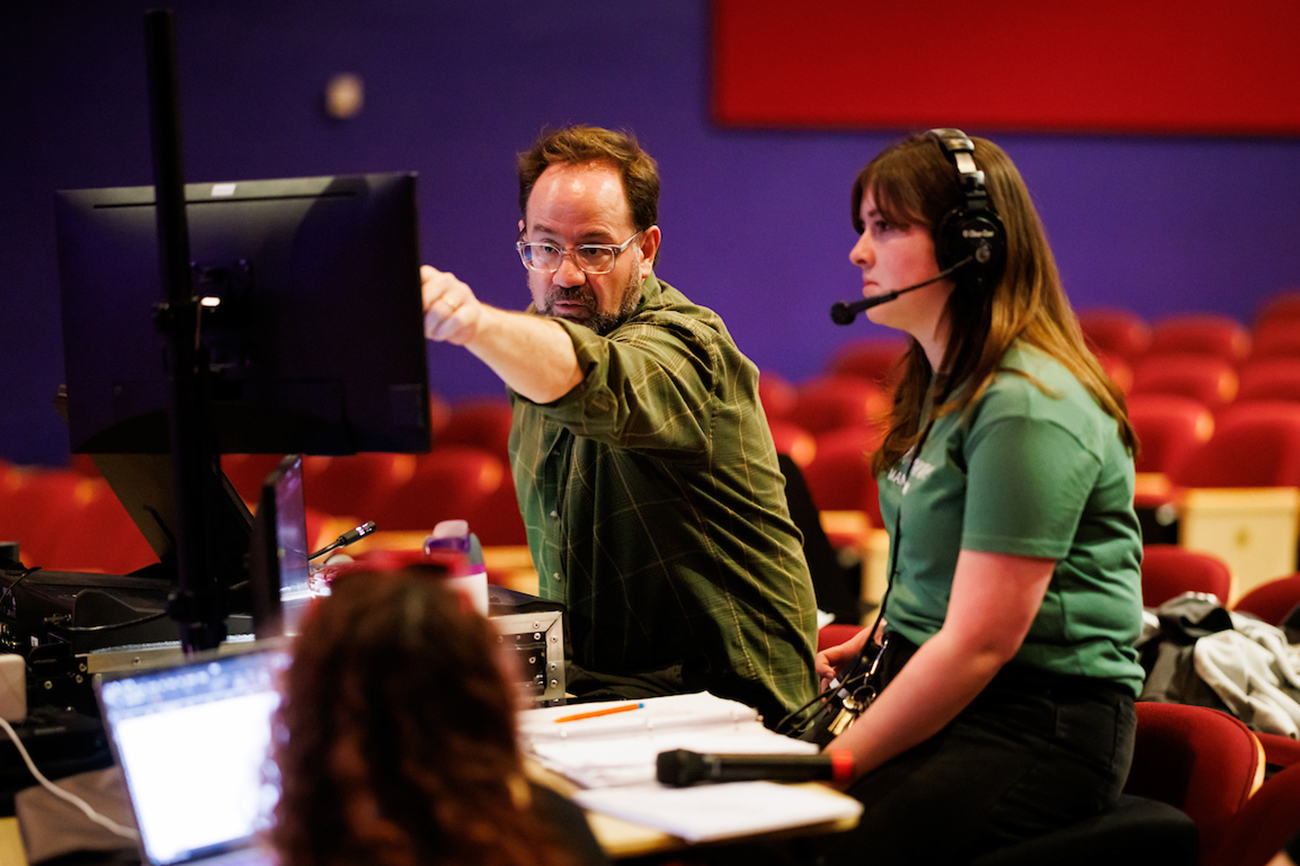
First photo: Technical director and faculty member Richard Jackson (right) walks the cast through the set’s features. Second photo: A carefully-organized table backstage holds the show’s collection of murder weapons and other crucial props. Third photo: Lighting designer and faculty chair Brian Healy (left) works with stage manager Claire Lawson (right) on cueing the show’s light effects.
This is Claire Lawson’s time to shine. A third-year theater major with minors in media arts, society and technology and entrepreneurship, she serves as the show’s stage manager. The role makes her the production’s quarterback from the final rehearsals through the end of the performance run.
Connected to every crew member with a live headset mic, it’s her job to keep track of and cue each part of the show’s technical side — when the music starts, when the lights and visual effects hit, what each member of cast and crew is doing and when. From her temporary command center in the middle of the theater, she’s checking on crew members and calling out commands: Cue thunder. Spotlights up. Go music.
“I’ve done this on a smaller scale before, but because this is a main stage musical, there are so many more factors to manage,” she says. “On the last show I managed, we had maybe 60 cues I had to keep track of. This time I have 500, so it’s a little bit hectic and can feel at first like everything is happening at once. But you learn it as you go through the process, and you start to learn the show backward and forward.”
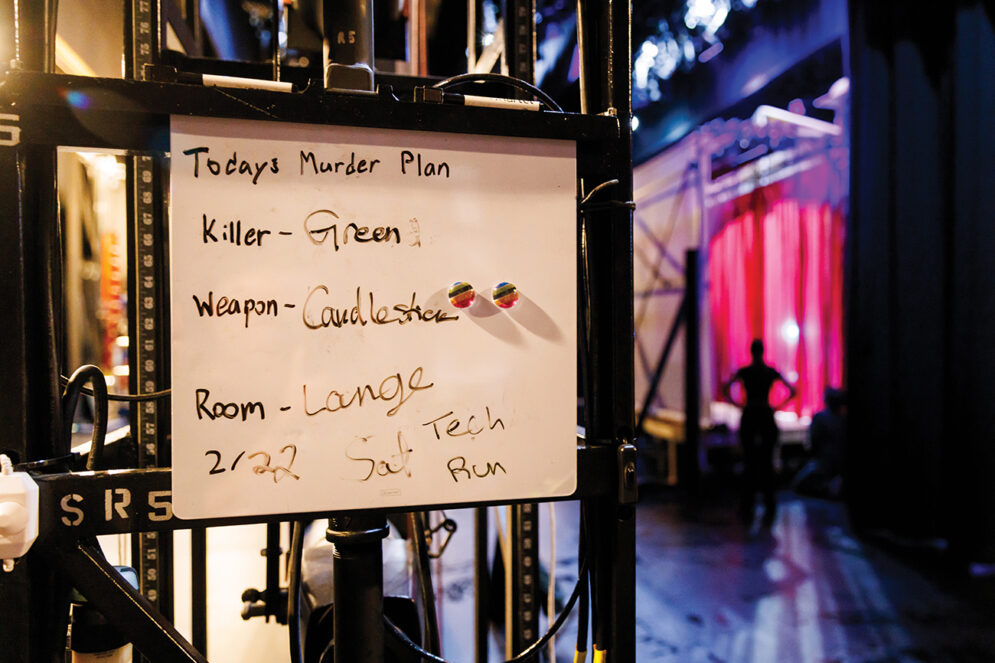

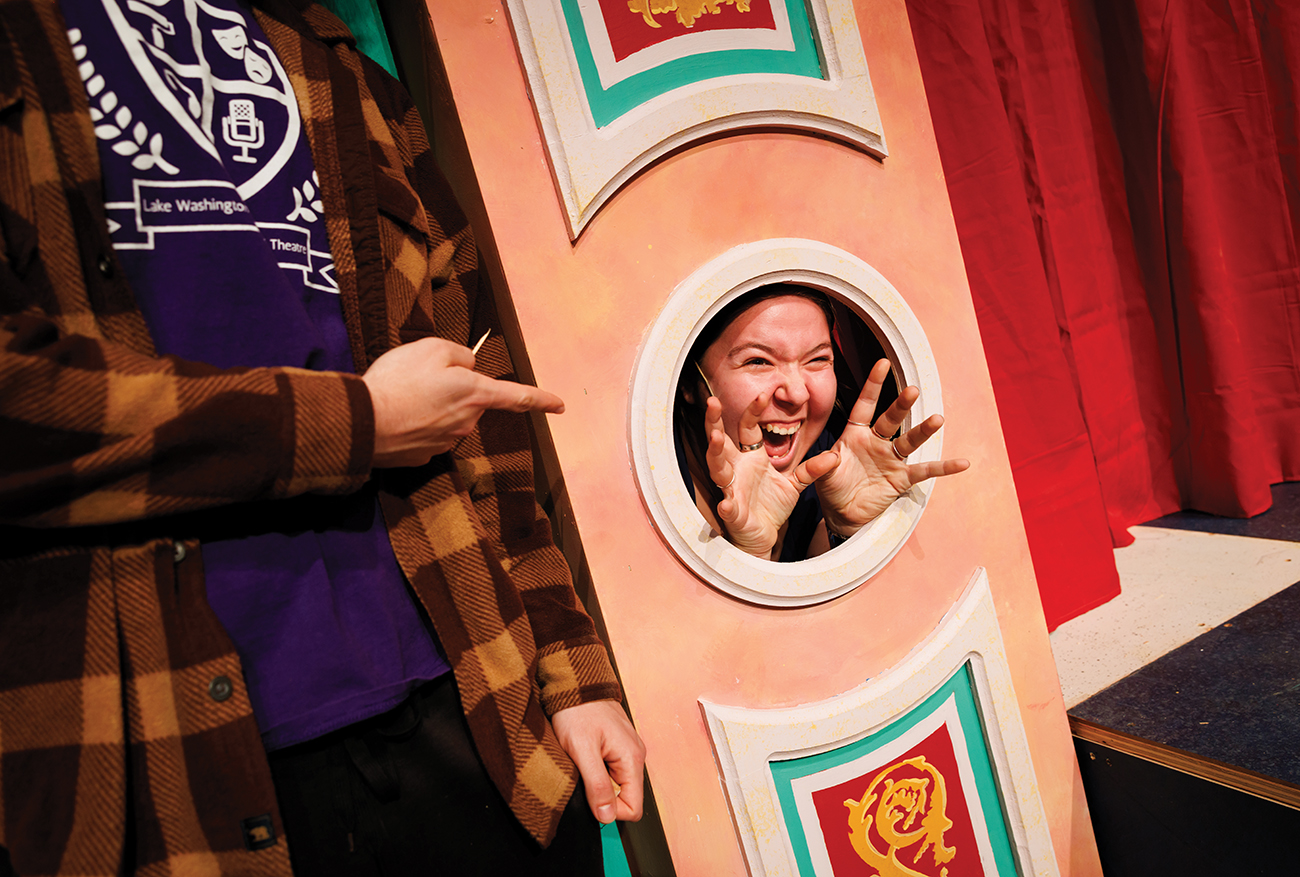
First photo: The board where the crew tracks the suspect, weapon and location of each performance’s murder. Second photo: Construction management student Uriel Gutierrez takes notes during a break from lighting tech duties. Third photo: “Mrs. Peacock” actress Casey Reichenthal explores the space.
It’s invaluable practice for Lawson, who plans to translate her extensive backstage experience into a career running her own entertainment company.
“It’s testing me on my communication skills,” she says. “This is very much a role where you have to communicate with everyone on the team, and it’s really given me a chance to see how every aspect of the design process and the production process comes together.”
Tech week is a critical point in the production because it’s the last chance for Hendricks and the directorial team to make any necessary adjustments. Once the performances begin, the director usually steps away and the show is considered “locked” — no further adjustments unless something goes very wrong.
“I’m so excited, but I’m definitely a little nervous too because there are always just a few kinks — things that we’re still working on improving before opening night,” says Marchal. “But I have so much faith and trust in everybody on this team, and I know that by the time we have to, we’re going to rise to the challenge.”
Stage, sound and lighting tech students work behind the scenes at the tech rehearsal to bring all the show’s elements together.
Curtains Up
Spanos is packed for the preview night. It’s the final rehearsal before the official opening, but it’s also the first time running through the play in front of a real audience — all the department’s students, faculty and staff have been invited, as well as friends and special guests of the cast and crew.
A melancholy jazz tune drifts through the auditorium, setting the stage for murder. After wandering through the first few rows, warming up the audience with magic tricks, Lewis selects a few audience members to draw the cards that seal his character’s fate, and then the first show begins.
It’s a flashy, colorful farce of a play, filled with over-the-top characters, scandalous moments of melodrama, and plenty of singing and dancing. By the end of the play, some audience members call out that they’ve guessed correctly — tonight it’s Professor Plum with a rope in the conservatory — but no one has foreseen the shocking twist of an additional killer. The audience gasps in delight when he delivers his surprise monologue.
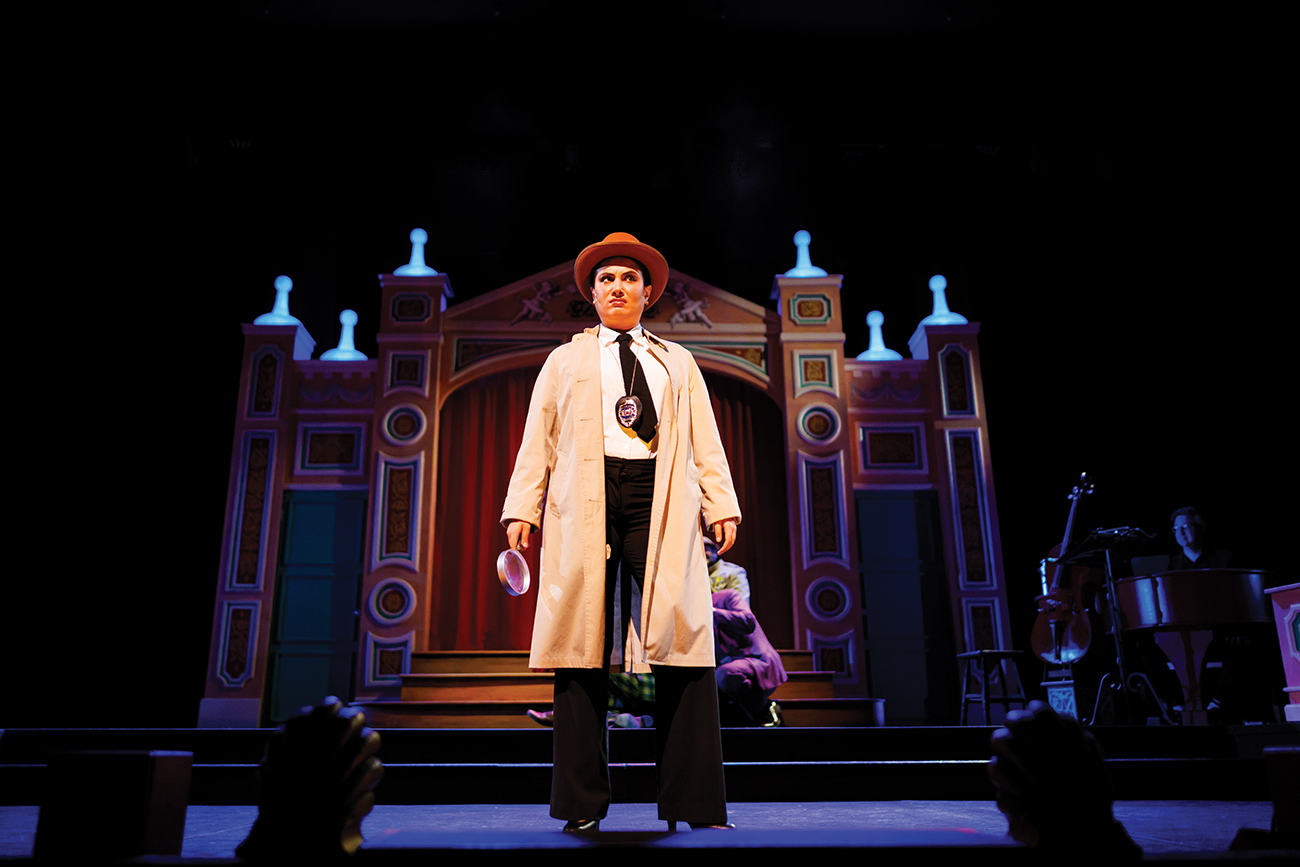
“Detective” Marya Wanous makes her big entrance.
It’s a strong start to a six-show run over two weekends, and once the ball is rolling, the cast and crew are able to settle into a routine.
“Once the show is locked in, the performance run is in some ways a lot easier than our rehearsal schedule — we can just show up every evening, perform for two hours and go home,” says Lewis. “We can focus on continuing strong, having a good time and keeping the energy up. This has actually been one of the smoothest runs of any show I’ve been a part of.”
But like many theater students, Lewis has already hit the ground running on his next role. Before Clue even opened, he had begun rehearsals on his senior capstone project: producing and starring in a campus production of the musical “The Last Five Years.” The ambitious project has involved securing grants to fund the show, negotiating the rights to the play, hiring and directing a 15-person creative team, and working with the entire department to book rehearsal and performance spaces.
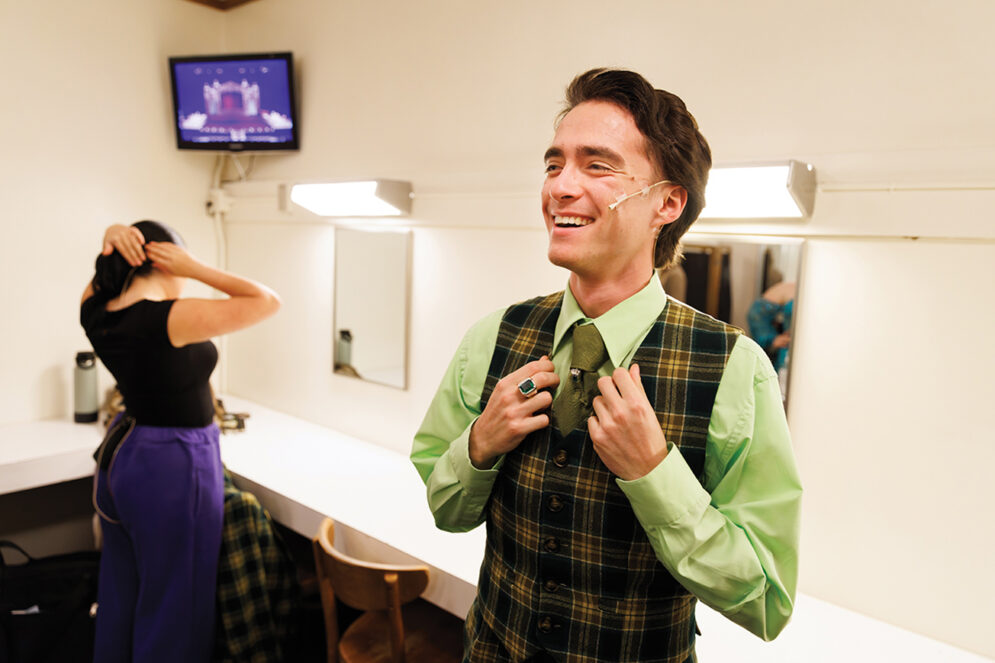
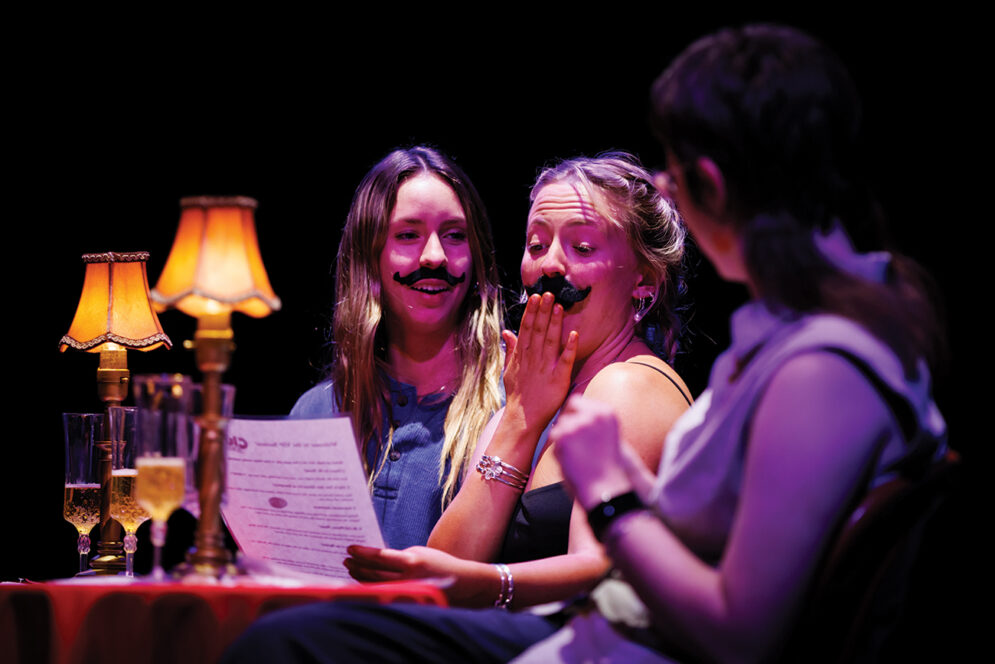
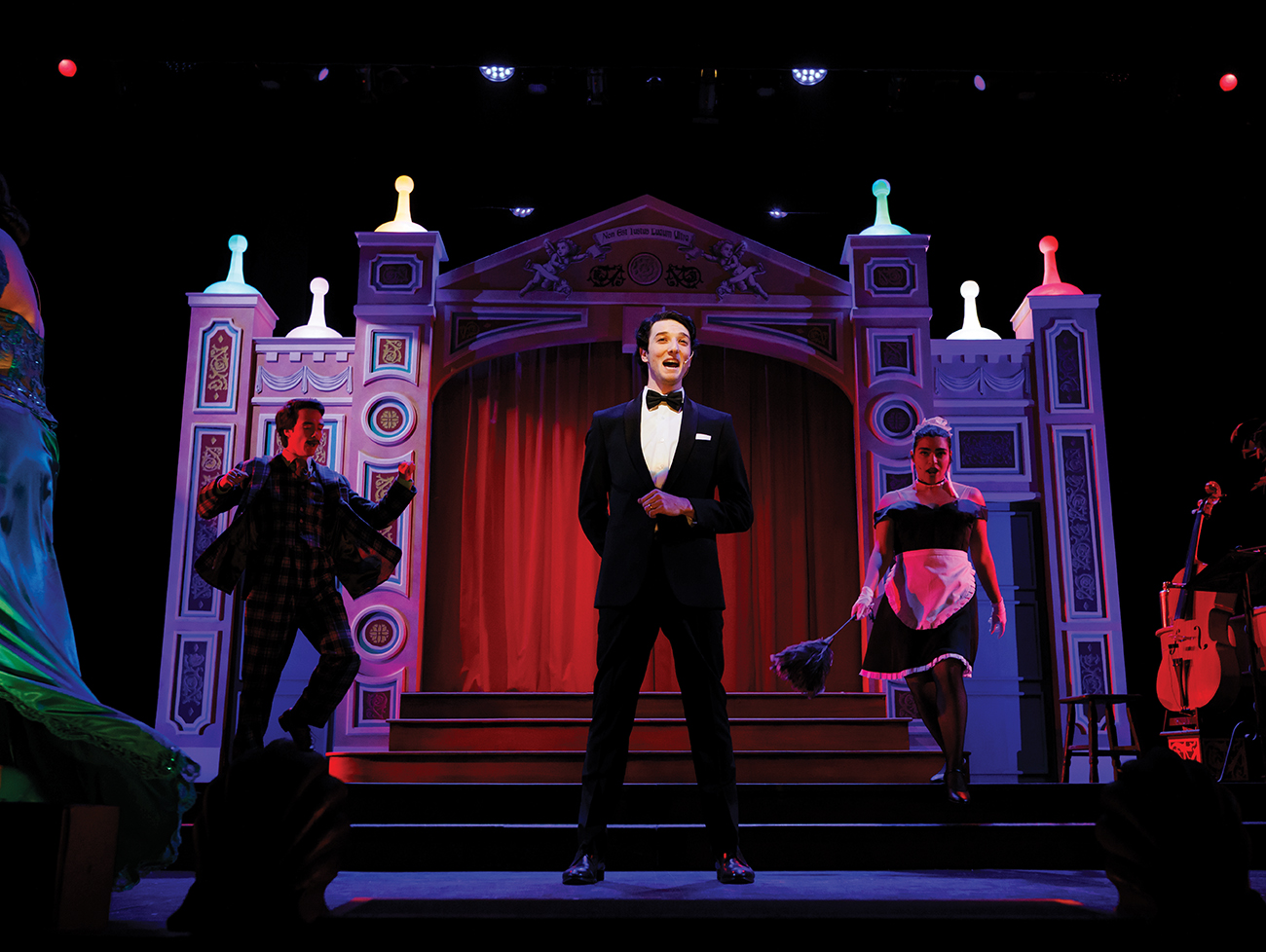
First photo: “Mr. Green” actor Josh Schneider suits up for a show. Second photo: Members of the costume crew enjoy the view from seats on stage at the final tech rehearsal. Third photo: Lewis shares a scene with Schneider and “Mrs. White” actress Sophia Moreno.
All invaluable experience for someone who’s about to graduate and move to New York with goals to join an industry that’s notoriously challenging to enter.
“We really do get a taste of everything in this program — they give us this tool belt of opportunities and knowledge,” he says. “I can confidently walk into any theater and fill pretty much any job opening they might have.
“It’s like getting 10 years of experience in the industry in four years,” he says. “We really are Ready Day One, because this program sets us up for success.”
Your Next Read
At the Women’s Mobile Health Unit, students explore the medical field while providing free care to a vulnerable population.
In an age of loneliness among young people, meet four Mustangs who have found different ways to forge lasting friendships that fuel their joy.



